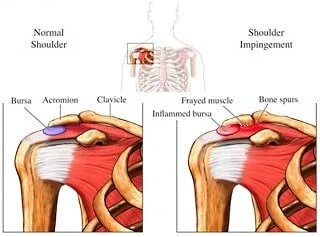Do you really have Frozen Shoulder?
Do you really have Frozen Shoulder (Adhesive Capsulitis)?
Shoulder pain and restriction are common symptoms reported by everyone as they age. Most people seek help to relieve these symptoms and often receive the diagnosis of Frozen Shoulder. Unfortunately in a lot of cases this is incorrect as you will see below many shoulder conditions feature similar characteristics so can be easily confused. It is important that you see a physiotherapist so that they can thoroughly assess and advise on the optimal treatment for you.
What is Frozen Shoulder?
This condition causes thickening and tightness of the shoulder capsule and is associated with restriction of both active and passive movement as well as significant amounts of pain especially in middle aged women. The usual pattern is of a gradual onset, a worsening of pain with time and followed by an eventual resolution. The cause is unknown but it has been linked to other conditions such as diabetes, heart disease, shoulder trauma and surgery, inflammatory disease, cervical disease and hyperthyroidism.
What happens when my shoulder freezes?
Normally occurring in three distinct phases, each lasting between 6-9 months
Can physiotherapy help me?
Physio in the initial stage is focused on retaining range of motion in the shoulder as well as pain relief. Through a combination of manual therapy, modalities and exercise programs, physio can help limit the extent of the condition
During stage 2, as pain has already decreased, the physio can work more vigorously on your shoulder to help regain range of motion to speed up your return to a normal lifestyle. Exercises can be provided plus manual therapy and modalities can be utilized to help with any remaining pain.
Phase 3 focusses on returning if not improving your shoulder to the level before the onset of frozen shoulder. Treatment focusses on restoration of full range of motion, strength training, biomechanics training especially at the shoulder plus achieving full functional activity.
Common Misdiagnoses
Subscapularis Trigger Points
Active trigger points in the subscapularis muscle are known to cause a severe pain deep in the back of the shoulder as well as tenderness at its attachment at the front of the shoulder. These trigger points also limit the lengthening of the muscle causing joint restriction and decreased range of motion which often is why it is mistaken for frozen shoulder. Fortunately, this is easily treated with manual therapy by a physio so you can quickly return to your normal lifestyle.
Subacromial Impingement Syndrome (SIS)
A condition that arises from decreased space within your shoulder joint which compromises the passage of the soft tissues through this area, including rotator cuff tendons, bursa and long head of biceps. SIS normally leads to pain especially with overhead movement which normally leads to restriction of movement. SIS is caused usually by instability, poor biomechanics, trauma, overuse injuries etc. Physiotherapy made up of manual therapy and exercise prescription has been shown to be most effective in treating SIS
Rotator Cuff Disease
This describes damage to any of the four main shoulder stabilisers, be it an acute injury or from repetitive strains. This covers minor strains, partial tears as well as complete tears leading to loss of joint function. Normally causes pain throughout the shoulder especially as site of injury, causes altered movement patterns that then lead to poor biomechanics and further disability. Its treatment involves pain relief as well as range and strength restoration. The cause needs to be identified and modified so as to prevent re-injury.




